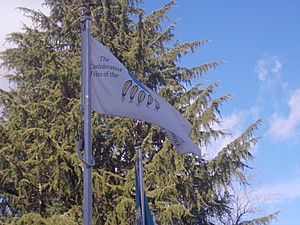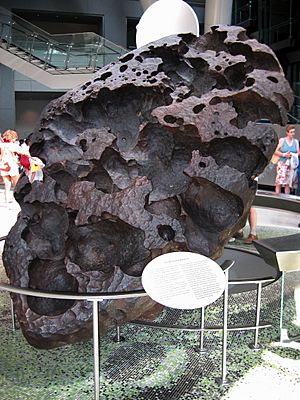Confederated Tribes of the Grand Ronde Community of Oregon facts for kids

Tribal flag
|
|
| Total population | |
|---|---|
| Enrolled members: 5200 | |
| Regions with significant populations | |
| Languages | |
| English, Chinook Jargon |
The Confederated Tribes of the Grand Ronde Community of Oregon (CTGR) is a group of twenty-seven Native American tribes. These tribes have strong historical connections to what is now western Oregon. Their lands stretch from the Oregon Coast in the west to the Cascade Range in the east. To the north, their lands reach into southwestern Washington, and to the south, into northern California.
The community has an Indian reservation called the Grand Ronde Indian Reservation. It covers about 11,288-acre (45.7 km2) and was created in 1855. It is located in Yamhill and Polk counties.
After many tribes were brought together on this land in the 1800s, they started speaking a common language called Chinook Jargon. Even though people were later forced to speak English, the tribes are working hard to preserve Chinook Jargon. They speak it as much as they can, especially with children.
Contents
Tribes of the Grand Ronde Community
Many tribes were moved to the Grand Ronde reservation. Here are some of them:
- Chasta (or Shasta) from Oregon and California
- Chasta Costa (Southern Oregon Athapaskan speakers)
- Kalapuya (including Yamhill, Mary's River, Mohawk, Tualatin, Yoncalla, Ahanyichuk, Santiam bands)
- Molalla (Santiam Band and Molalla)
- Rogue River (a mix of Takelma, Upper Umpqua, and Rogue River Athapaskan tribes)
- Klickitat
- Chinook (including Thomas Band, Williams Band, Wal-la-lah band of Tumwaters, Johns Band, Clackamas Chinook)
- Tillamook (including Salmon River, Nehalem, Nestucka bands)
- French-Canadian (Iroquoian)
Treaties with the United States
The United States made several treaties that led to the creation of the Confederated Tribes of Grand Ronde. These treaties include:
- Treaty with the Chasta, etc., 1854
- Treaty with the Kalapuya, etc., 1855
- Treaty with the Molalla, 1855
- Treaty with the Rogue River, 1853
- Treaty with the Rogue River, 1854
- Treaty with the Umpqua-Cow Creek Band, 1853
- Treaty with the Umpqua and Kalapuya, 1854
History of the Grand Ronde Tribes
Seven treaties with the United States led to the relocation of twenty-seven Native American tribes. They were moved to land along the South Yamhill River. The Grand Ronde Reservation was officially created in 1857.
In 1887, a law called the Dawes Act was passed. This law gave a small piece of land to each tribal member who had at least half Native American heritage. Any land that was not given to tribal members was sold. Each tribal member received $72 from the sale of this extra land.
In 1936, the Grand Ronde people voted to organize their government more like the United States government. However, in 1954, the U.S. Congress ended its special relationship with the tribe. This meant the land they lived on could now be taxed. Many people lost their homes, had to change schools, and had to pay for medical care.
In 1988, a small part of the original reservation was given back to the Grand Ronde tribe. Today, this land is used for timber, fun activities, and traditional harvesting (gathering food and resources).
The Tribes started a monthly newsletter called Smoke Signals in 1978. It is now a newspaper published twice a month.
Tribal Languages and Revival Efforts
Historically, people from the Grand Ronde tribes spoke twenty-seven different languages. Many tribal members could speak more than one language. This was helpful for trading goods with nearby tribes. On the reservation, most Native Americans began to speak Chinook Jargon, which was a common trade language.
During a time called the termination era (from 1954 to 1983), children were sent to Indian boarding schools. There, they were forced to learn English. Because of this, all the individual tribal languages at Grand Ronde eventually disappeared as their last native speakers passed away.
In the 1970s, older members of the Grand Ronde community started teaching Chinook Jargon classes. The language program now plans to expand. They want to offer an "immersion" program from preschool through eighth grade, along with classes for adults. This will help create new speakers and keep the language alive.
Grand Ronde Culture
Oregon State Bill 13 helps pay for people who create school lessons. These specialists develop lessons about the history of the Confederated Tribes of Grand Ronde. The lessons teach students about the important role Native Americans played in Oregon's history.
To help keep the Chinook Jargon language (also called Chinuk Wawa) alive, the tribes created an immersion program. Kindergarteners and first graders learn the language by hearing it constantly. They are "immersed" in the language. In 2012, the tribe published a Chinuk Wawa dictionary called Chinuk Wawa: As Our Elders Teach Us to Speak It.
In 2010, the tribe built a traditional plank house on the reservation. In 2011, they added an exhibit about the tribe's canoe traditions at the Willamette Heritage Center. It was called Grand Ronde Canoe Journey.
Every year, the reservation hosts pow wows and a Round Dance. These are special gatherings with dancing, singing, and community celebration.
The Reservation Today
The Grand Ronde Indian Reservation covers about 11,288-acre (46 km2). It is located in Yamhill and Polk counties in Oregon. In the 2000s, the tribe had over 5,500 members.
Economy of the Tribes
The Confederated Tribes of Grand Ronde employ around 1,600 people. Most of their money comes from the Spirit Mountain Casino. By 2023, the Spirit Mountain Community Fund had given more than $95 million to non-profit groups. This makes it one of Oregon's largest charitable foundations. The tribes also earn money from managing their timber resources.
Tribal Membership
The elected tribal council decides the rules for becoming a member. Usually, you need to be a direct descendant of someone listed on the tribal rolls at certain times. You also need to have a certain percentage of Native American ancestry from the tribes in the Confederation. Being a tribal member can offer financial benefits, estimated between $3,500 and $5,000 per year. This amount does not include health care benefits.
The Grand Ronde Tribal Council was created by the Tribal Constitution. It has nine members, and each serves a three-year term. Members can be re-elected as many times as they wish. Anyone who is eighteen years or older and an enrolled member of the Tribe can run for election to the Tribal Council.
Important Decision About Tribal Membership
In 2014, the tribal council made a decision to remove sixty-six living people and six deceased people from the tribal membership. These individuals were descendants of Chief Tumulth. This decision meant they lost their tribal rights. The reason given was that their ancestor had signed a treaty in 1855 with the United States, which involved giving away tribal land and agreeing to the relocation of the Grand Ronde reservation.
However, in 2016, the tribal Court of Appeals reviewed this decision. They overturned it and allowed the sixty-six living descendants of Chief Tumulth to become members again. This was a very important moment because it was the first time a tribal court had reversed a tribe's decision to remove its members.
Tomanowos, or the Willamette Meteorite
Since the year 2000, members of the tribe travel to New York City every July. They go to see Tomanowos, also known as the Willamette Meteorite. This large meteorite was taken from Oregon many years ago and is now displayed at the American Museum of Natural History.
The Clackamas people, who are one of the Grand Ronde tribes, have a traditional belief about this 15-ton meteorite. They believe it is a sacred 'sky person' who fell to Earth thousands of years ago. They believe it helped create their people and their world. In June 2000, the American Museum of Natural History and the tribe agreed to share control of the meteorite. This helps to protect it for both religious and scientific reasons. The museum also agreed to offer internships for Native Americans. This helps build new connections and creates opportunities for young students.
Interesting Facts About the Confederated Tribes of Grand Ronde
- The 325 "Indian Refugees" who were moved from the Table Rock Reservation in Southern Oregon walked along the Rogue River Trail of Tears.
- The journey along the Rogue River Trail of Tears started on February 23, 1856, and ended on March 25, 1856. During this journey, eight people died, and eight babies were born.
- Most of the Grand Ronde Tribes' reservation land was taken from them in the early 1900s. They have been able to get back just over 12,077 acres of the original 60,000+ acre reservation.
- The Tribe’s traditional territories include Washington, Marion, Yamhill, Polk, Tillamook, and Multnomah counties.
- Spirit Mountain Casino is one of Oregon’s most popular tourist attractions.
- The Confederated Tribes of Grand Ronde started a project to preserve the history of the tribes. They have created seventeen lessons for eighth graders in several school districts in Oregon.
- Sixty-five elders from the tribes were interviewed to gather information for these history lessons.



